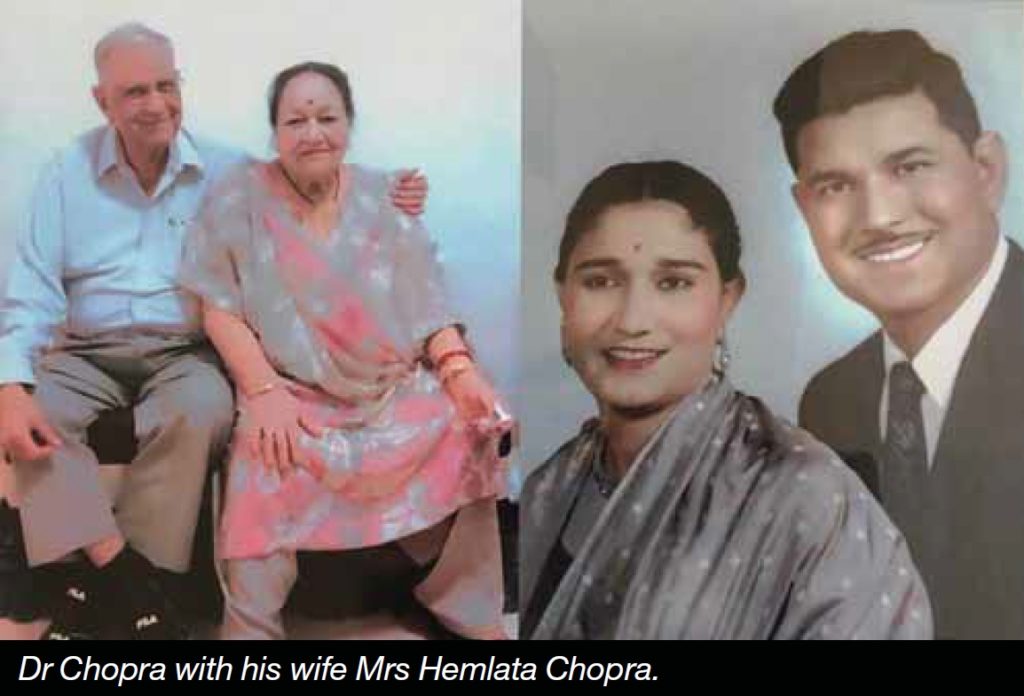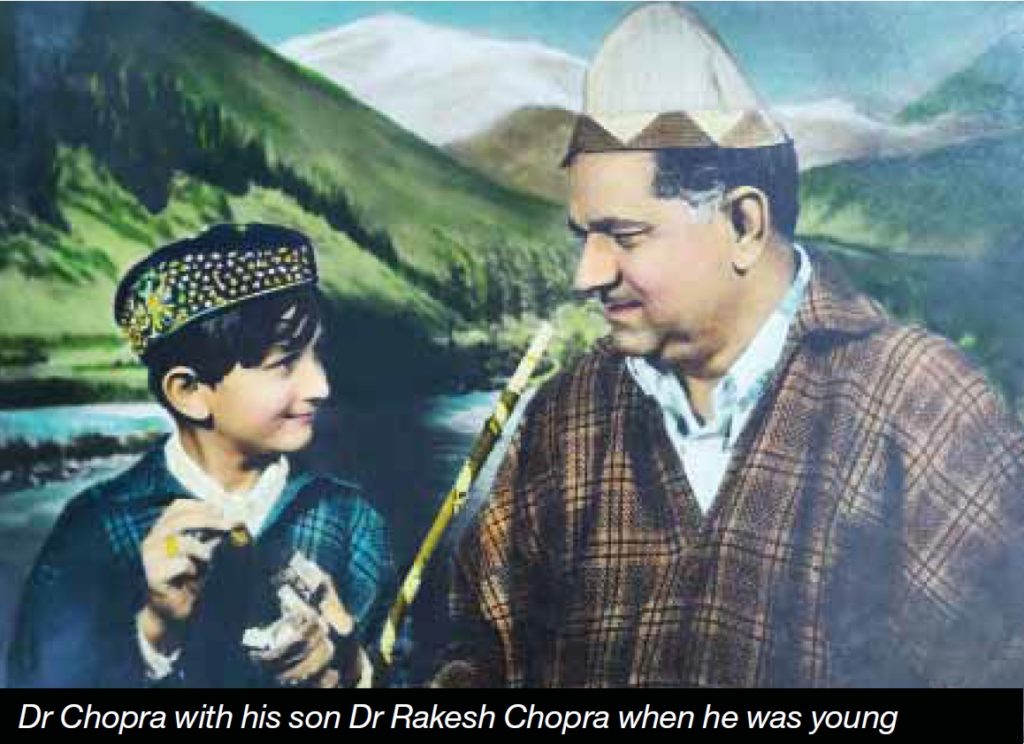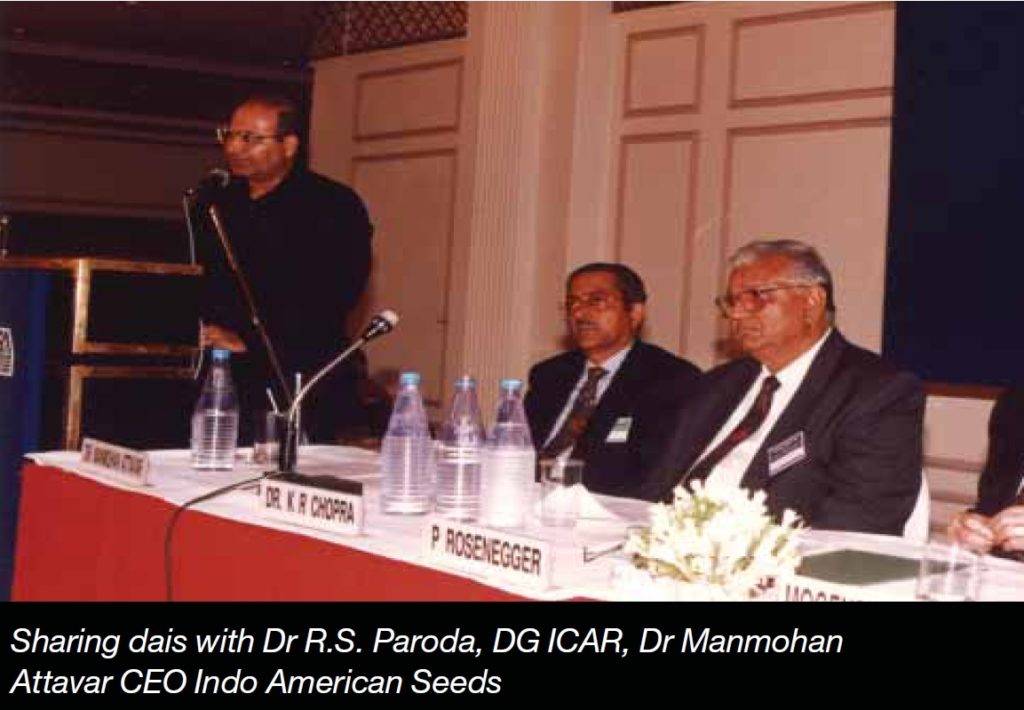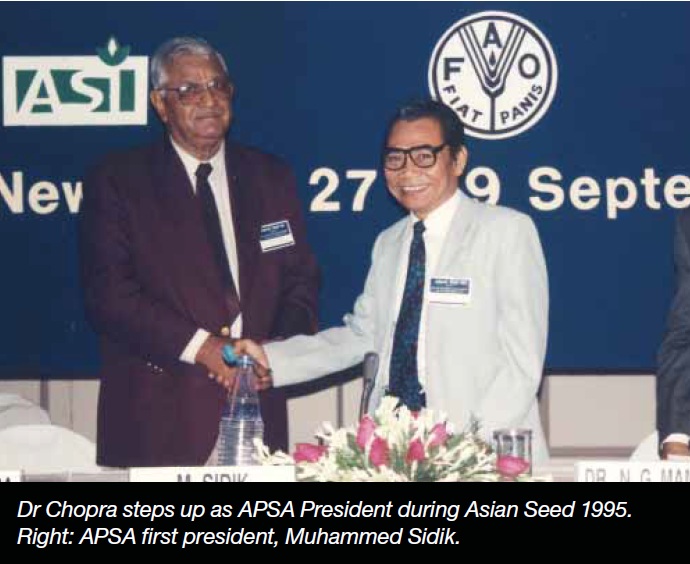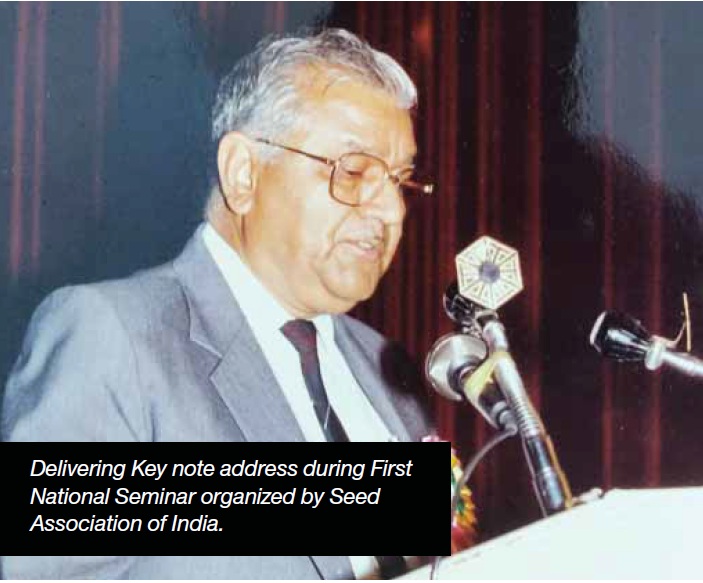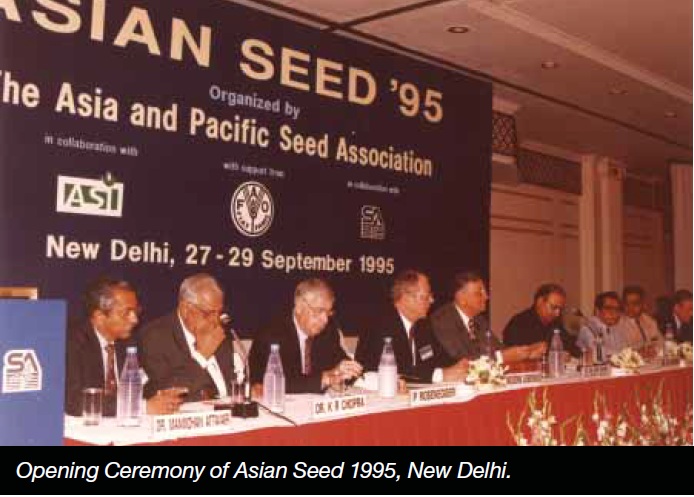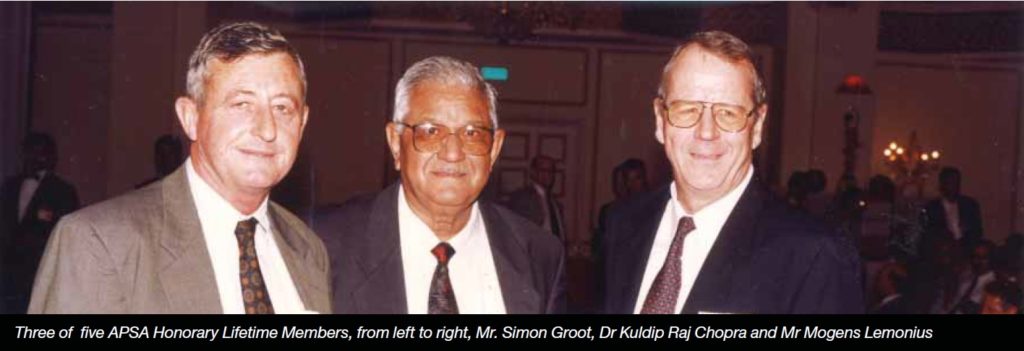The light of Asian Seed flickers

1933 _ 2020
Remembering the late Indian seed pioneer and APSA co-founder Dr Kuldip Raj Chopra, Researcher, entrepreneur, co-founder and honorary lifetime member of APSA, passed away on 6th February, aged 86. Obsequies were held in Hyderabad. A seed industry giant, Dr Chopra’s career spanned more than half a century – his infl uence felt by farmers in their fields, in academia, business, and in government.
Born 7 November 1933 in Lahore, in what is now Pakistan, he was the third of seven children and was affectionately named Kuldip (‘Kul’ means ‘family’ and ‘dip’ means ‘light’, so his name literally means ‘light of the family’). After primary school, he attended a government high
school in Lahore before moving in 1947 to Allahabad, in Uttar Pradesh, central India. There he attended Allahabad Agricultural Institute, graduating in 1953, before going on to pursue his Master’s in Agriculture Botany in 1956 and his PhD in Agronomy from the University of Nebraska.
His professional career began as a research assistant with the All India Coordinated Maize Improvement Project wherein the Indian Council
on Agricultural Research (ICAR), state agriculture universities and the Rockefeller Foundation cooperated in collecting, characterizing and developing stable, high yielding lines of disease and pest tolerant germplasm for adaptable Maize Hybrids (1957-59) at the Indian Agricultural Research Institute (IARI) in New Delhi.”The mid-fi fties were a crucial period in India’s agricultural sector,” he recalled in 2017 during an Asian Seed interview. “Crop yields were low because no organized mechanism for dissemination of new varieties and new technologies yet existed.
“Agriculture was an area overseen by the states, and there was hardly any coordination — even among scientists working on the same project – among states.” To overcome such bottlenecks, in 1955, India’s government asked the Rockefeller Foundation, which had programs in Mexico and Columbia, to help systematize India’s agricultural research, production of superior genotype seeds and marketing. The Foundation sent two experts whose 1956 report led to establishment of the country’s All India Coordinated Projects system for each major crop, starting with maize in March, 1957. “Destiny brought me in touch with Dr U.J. Grant, who was then the Rockefeller Foundation’s Deputy Director
General and Maize Breeder. Thus my professional career began.” As a junior maize breeder for the Rockefeller Foundation, Dr Chopra conducted maize improvement work at four main- and nine sub-stations, from 1959 to 1961, resulting in release of four maize hybrids. It was the beginning of India’s entry into the “Hybrid Era” and the country’s fi rst “green revolution”. He then detoured to the US for education: “From 1961 to 1964, I studied
at the University of Nebraska, Lincoln, where I obtained a PhD in Agronomy, before joining as a breeder in the All India Sorghum Improvement Project, from 1964 to 1966.” Among the most versatile plants in cultivation, sorghum provides food, molasses, fodder, alcoholic beverages,
and biofuels, among others, ranking in the world’s top fi ve cereal crops. Like maize, its use is ubiquitous in the food industry – and it was his work with sorghum that inspired Dr Chopra to found his own business.
“Destiny again guided me,” he said, in acting on the advice of a Rockefeller Foundation Sorghum Breeder, Dr Lee House, to take advantage of private sector opportunities: “I was one of the few qualifi ed professionals to resign a secure government job,” he observed
wryly. Superior hybrids and varieties having been released during the late sixties, USAID and the Rockefeller Foundation were assisting in establishment of India’s seed production, processing, quality control and marketing networks. Dr Chopra set up a small company in the country’s nascent private seed sector – the Mahendra Hybrid Seed Company. Focus was on maize; sorghum; sunfl ower and oilseeds; Pearl millet; cotton and fi ber crops; and temperate and tropical horticultural varieties. From 1971 to 2002 he led Mahendra to become one of the leading, researchbased companies specializing in improvement, production, processing and marketing of proprietary and publicly bred varieties. Since 2004

Dr Chopra was shareholder and Founder of Biostadt Mhseeds Pvt Ltd, with a smiliar mandate as his role in Mahendra. Dr Chopra led the new entity till retirement in 2014. He never abandoned the public sector, however, working from 1973 onwards as a consultant with the Food and Agriculture Organization of the United Nations (FAO), the World Bank and their affi liates in seed industry development: “Over the years, I’ve done over 28 consultancies,” he told APSA, “the most recent ones concerned setting up R&D systems.” He advised on privatization of governmentcontrolled systems; farm seed production; and establishing effective seed production and marketing networks in both command and free market economies, while also conducting training programs for FAO and World Bank-sponsored trainees. Former International Crops Research Institute for the Semi-Arid Tropics (ICRISAT) Deputy Director General and GRSV Consulting Services co-founder Dr CL Laxmipathi Gowda, refl ecting on their work together, had this to say about his colleague: “Dr K.R. Chopra was a visionary, and the doyen of partnershipresearch. His contribution to initiate the Public – Private Sector Partnership with ICRISAT deserves mention. “The whole CGIAR (Consortium of International Agricultural Research Centers) system was undergoing a fi nancial crunch in the late 1990s, and that affected funding for R&D at ICRISAT. This funding crunch would have long-term negative impact on private sector seed companies dependent on the hybrid parents of sorghum and Pearl millet for their commercial hybrid programs.. “The ICRISAT team comprising myself, K.N. Rai and Belum Reddy had several rounds of discussion with Dr K.R. Chopra and G. Harinarayana on generating funding from private sector seed companies to augment ICRISAT’s R&D in sorghum and Pearl millet crop improvement programs. “That led to initiation of the ICRISAT – Private Sector Hybrid Parents Research Consortium for Sorghum and Pearl Millet in 2001. Seed companies agreed to contribute funding and become members.” Members got priority access to the elite hybrid parents used to develop superior commercial hybrids. “Starting with about 12 members in 2001,” said Dr Gowda, “the consortium had more than 50 members in 2009, enabling ICRISAT to receive nearly US$1.2 million to support crop improvement research. The partnership enhanced synergies between the social equity of public institutions’ research and effi cient delivery of hybrid seeds by the private sector.” He said this model has been emulated by several public sector institutions in India and a few CGIAR Centers. “The greater part of credit for this bold and innovative venture,” he averred, “should go to Dr K.R. Chopra.” Life took a new turn for Dr Chopra when ICAR sent an FAO-sponsored team of young seed entrepreneurs from Africa to visit Mahendra in 1973: “FAO team leader Dr Wagner – a senior offi cer from the FAO seed unit in Rome – was highly impressed by our in-house R&D, production and quality control systems,” he recalled. That led to an offer from the FAO to study seed sector infrastructure in Cameroon and Sri Lanka, and development of quality seed production and sales networking programs focused on bolstering the countries’ nascent private sectors. His report on the project was commended by the FAO, and resulted in more such work from 1974 till 1998 with that organization and the World Bank: “It brought additional income, and a good use of free time away from my from company responsibilities,” he explained. “I preferred consultancies in Asia, and between 1992 and 1998 my assignments were primarily in Bangladesh, Sri Lanka, Nepal, Burma and China.” His experiences convinced him that what was needed were: exposure to neighboring countries’ success stories and a forum for interaction; judicious use of funding for small R&D projects; government support to minimize risk of failure; access to new technology; and a platform for transacting business. As a director and past president of the Seed Association of India (SAI) – seeing the benefi ts it provided to new seedsmen; membership from both private industry and government, of companies large and small; and interaction with public sector agencies on issues of policy – he had a good idea of what that platform might look like: “I always got positive response whenever I discussed creation of a regional forum with seed entrepreneurs and offi cials of countries I visited,” he said. “The question was how and who would take the initiative.” The FAO, with its regional offi ce in Bangkok, appeared to Dr Chopra most suited, so he discussed creating such a forum with Mogens Lemonius, to whom he reported after each consultancy. Lemonius had since the early 1980s developed a regional network of seed industry contacts as part of an FAO project. Thus, in 1992, the FAO regional offi ce, under the leadership of Dr R.S. Paroda, called a meeting in Bangkok of senior agricultural offi cials, policy makers and seed entrepreneurs from the Asia Pacifi c region. Dr Chopra
and Lemonius presented an outline of their proposal, which – to their considerable surprise – received overwhelming support. A Preparatory Committee was constituted and Dr Chopra elected chairman. The FAO, at Lemonius’ persistent urging, committed US$2 million as seed money for initial expenses; offi ce space was provided by Thailand’s Department of Agriculture – and APSA was born. The Committee met fi ve or six times over the ensuing years, drafting the constitution and bylaws. In 1994 the fi rst of APSA’s Asian Seed Congresses was held, in Chiang Mai, led by Lemonius, and attended by some 200 delegates, with representation from companies large and small, and associate members from Europe and the US. Notable APSA contributors during that seminal period included R.S. Arora, Simon N. Groot and Manas Chiaravanond. At the second ASC in New Delhi, in 1995, hosted by the Seed Association of India, over 500 delegates registered and Dr Chopra was elected incoming President. In addition to his work with the SAI and APSA, Dr Chopra was also president of the All India Seed Growers and Merchants Association from 1990 to 1996; was a member of several state and national seed-related bodies, of the Confederation of Indian Industries and the National Technology Council. He authored many monographs published by the FAO and World Bank, including: Seed Enterprise Development and Management; Technical Guidelines for Sorghum and Millet Seed Production; Sorghum Seed Technology; and Global Assessment of Hybrid Rice
Technologies for Breeding and Seed Production, and likewise presented numerous technical papers at national and international conferences. Besides many regional, state, FAO and APSA awards, Dr Chopra received in 1994 ICRISAT’s most prestigious scientifi c honor – the Doreen Margaret Mashler Distinguished Scientifi c Achievement Award. Dr Chopra is survived by his wife, Mrs Hemlata Chopra, two daughters, son Dr Rakesh Chopra, six grandchildren, and three great-grandchildren. In addition to his honors, family and successful businesses, he leaves behind him a wealth of fond memories. We are deeply grateful to him.
